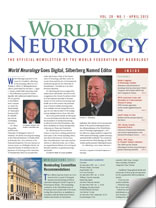It is both an honor and a challenge to assume the editorial responsibility for World Neurology as it is transformed into a truly contemporary publication, available exclusively online. Since 1984, my distinguished predecessors, Jagjit Chopra, Mark Hallett and Johan Aarli, worked hard and effectively to refine the attractive print version that to many has become staple reading.1 Although the initial motivation for the WFN leadership to make this change was lower publications costs, it soon realized that the advantages of instant access, the ability to embed references and website addresses (URLs), the addition of connecting via social networking sites and the sheer absence of paper are far more important than cost reduction. The ability to access World Neurology on your computer, iPad or smartphone brings us into the contemporary communication scene.
Importantly, the electronic format will permit ready coordination among the three WFN publications, the Journal of Neurological Sciences, edited by Robert Lisak; the WFN website, edited by Jerome Engel; and World Neurology. Part of the challenge will be to avoid all but essential redundancy among the three. Both Drs. Engel and Lisak will serve on the World Neurology Editorial Advisory Board.
The challenge is to motivate neurologists (and others who might be interested) to click on the URL and begin their electronic navigation. First, readers must know how to find us. The WFN Executive Office, together with the experienced media company that the WFN has enlisted to facilitate publication — Ascend Integrated Media — are developing a comprehensive email list. However, some email addresses may be missed, so please forward the World Neurology URL to any colleagues who might be missing.
Although the initial motivation for the WFN leadership to make this change was lower publications costs, it soon realized that the advantages of instant access, the ability to embed references and website addresses (URLs), the addition of connecting via social networking sites and the sheer absence of paper are far more important than cost reduction.
We will continue to publish important news from the WFN, reports of WFN activities in the field, reports from WFN’s committees and officers and this column. I invite all readers to contribute articles, thoughts, letters to the editor and unique illustrations to World Neurology. To do so, simply send material to my attention at silberbe@mail.med.upenn.edu.
I plan to include titles and brief abstracts of articles that have appeared recently that seem most important to global neurology. Breaking news at this time is the European project to attempt to recreate brain function via supercomputer simulation, and the U.S. initiative to map the functions of all brain neurons. These projects represent the neuroscience follow-on to the 1990s “Decade of the Brain,” celebrated in many countries, that sought to enhance public and legislative awareness of brain science and disorders. As these projects gradually yield practical applications, we must keep in mind the fact that 90 percent of the world’s population lives in regions that have few if any neurologists or health workers trained in cognate fields. We must do everything possible to provide the information and leadership that will benefit those with neurological disorders everywhere.
I look forward to working with all of you to take full advantage of our new ways to communicate.
References
-
Aarli, J. WNFN Newsletter Continues to Evolve. World Neurology, June 2012.

